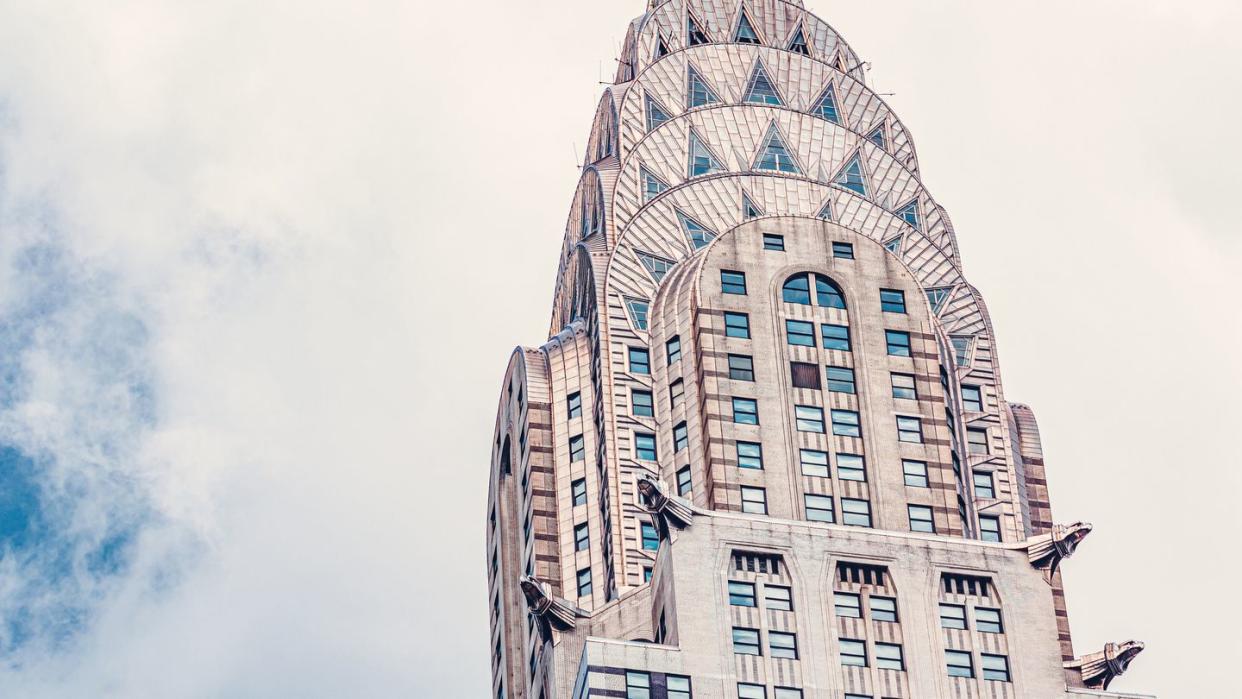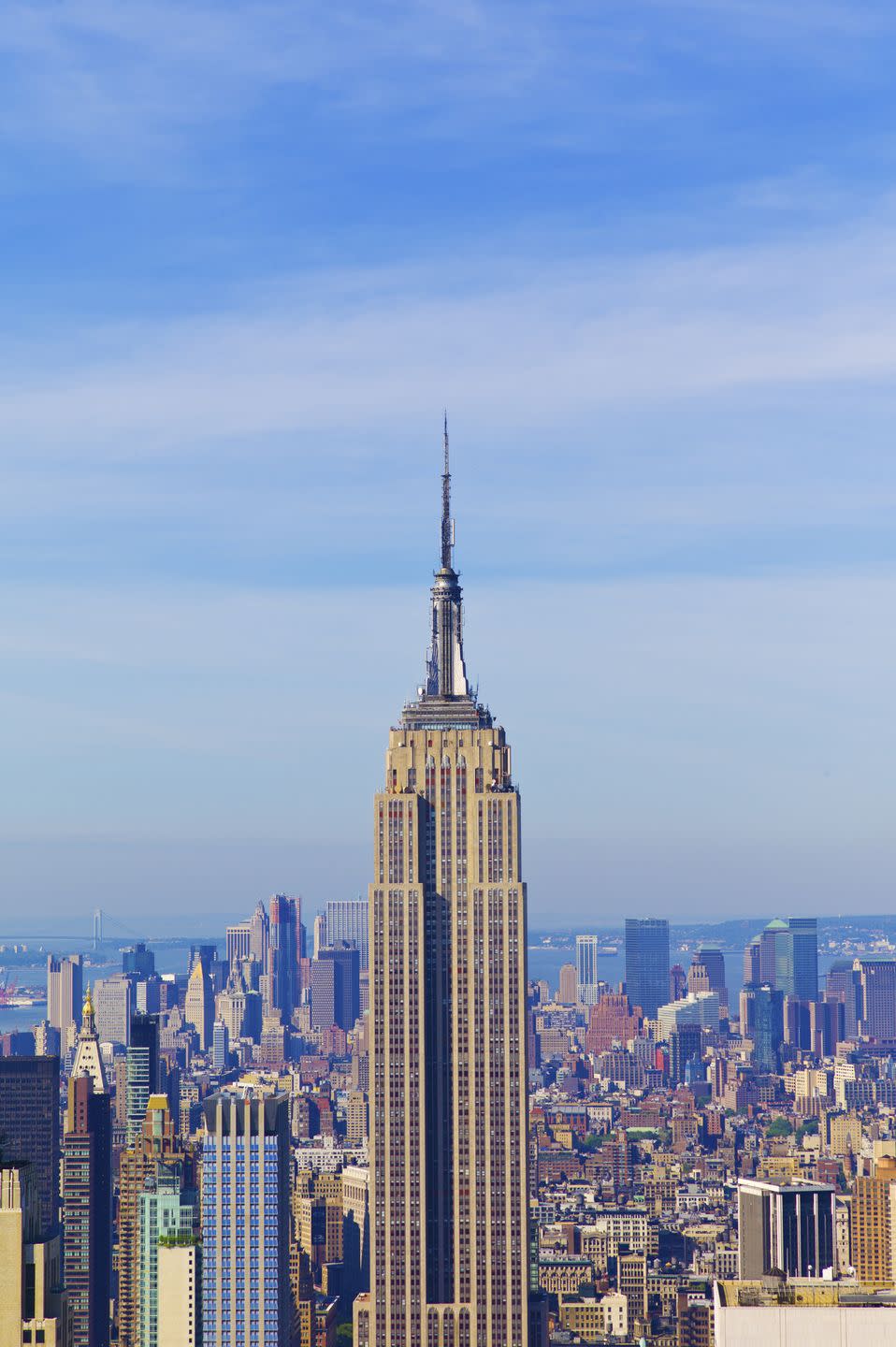Here’s What to Know About Art Deco Architecture

Ask three historians to define “Art Deco,” and you’ll likely get three varying answers. That’s because Art Deco is many different things to many different people, and its evolution is as unique as its expression in architecture, interior design, decorative arts and fashion.
One concept most experts agree on is that Art Deco defies narrow descriptions. “The style encompasses all kinds of architectural trends from the 1920s to the 1940s, though it often refers to the vertical style of the 1920s,” says Anthony W. Robins, vice president of the Art Deco Society of New York and author of New York City Art Deco: A Guide to Gotham’s Jazz Age Architecture.
Sometimes referred to modernistic or Style Moderne, Art Deco encompasses a variety of design aesthetics that were prominent in the late 19th and early 20th centuries, says Robins. The style drew inspiration from many other architectural traditions such as Art Nouveau, Cubism, and the Bauhaus, with an emphasis on the use of geometric forms, sleek lines, and manmade materials.
The style developed after the upheaval of World War I, when cities like New York were growing exponentially. “There was a movement among architects during the ‘20s and ‘30s to create something unique,” says Angela Starita, an architectural historian and instructor at the New Jersey Institute of Technology. “There was tension between ‘We have to copy everything they’re doing in Europe,’ versus ‘Why can’t we create something new?’”
Many factors helped designers turn away from historical designs to invent a new look that embraced the future, says Starita. For starters, a 1916 zoning resolution in New York City required buildings to taper inward with calculated setbacks in order to ensure adequate light and air for the streets and surrounding buildings below. This requirement necessitated a whole new level of creativity in design. In addition, new materials, such as a rustproof alloy called Nirosta, were now available for construction. “You couldn’t use cast iron for skyscrapers because it required maintenance or it would rust,” says Robins. “But this new metal was used to adorn the exterior of skyscrapers such as the Chrysler Building with a silvery glow.”
Read on to learn how the style evolved, as well as its key elements and where you can see shining examples of Art Deco architecture.
What is Art Deco Architecture?
Art Deco evolved as a culmination of the cultural, industrial and social influences of a unique time in world history. With America’s growth as a global economic power after WWI, increasing industrialization, and a growing middle class, New York became a brash, modern metropolis on the world stage, says Robins.
While Art Deco is found everywhere on every continent, New York City’s skyscrapers were at the forefront of the movement, says Robins. A small number of architects, who all knew each other, designed the iconic New York City buildings of the time from about 1923 to 1932, with each adding his own interpretation of the style.
Sadly, the Great Depression put an end to the building of these exuberant skyscrapers, with the last one opening in 1932. But, by then, Art Deco had made its mark. During the ‘30s and ‘40s, apartment buildings, hotels, department stores, movie palaces, banks, restaurants, and even filling stations and parking garages--many which remain and have been restored and repurposed today-- were built in the distinctive Art Deco style, says Robins.
Why Is It Called Art Deco?
The style typically was referred to the modernistic or vertical style during its heyday in the ‘20s and ‘30s. Interestingly, it wasn’t actually called “Art Deco” until much later. The term was coined in 1966 during a Paris expo that looked back at the influential design of the 1920s during the International Exposition of Modern Industrial and Decorative Arts of 1925, says Robins. That long expo title then became shortened to “Art Deco," or sometimes "Deco."
Most Common Features of Art Deco Architecture
Although Art Deco encompasses a range of seemingly disparate elements, there are obvious features that make a building an example of Art Deco. While not every building will include every feature, these are the hallmarks that common to most Art Deco buildings, say Robins and Starita:
360 degree design: The building typically can be viewed ‘in the round,’ from all sides, almost like a piece of abstract sculpture
Verticality: Uninterrupted bays of windows are stacked vertically, often recessed behind tall stripes of brick or other materials
Color: Varying shades of brick, terra-cotta or gleaming add brilliant hues to exterior design
Use of new materials: New alloys allowed the use of rust-proof metals on the exterior of buildings.
Stylized ornamentation and geometric patterns: Zig-zags, lightening bolts, sunrises, stylized florals, geometric curves and designs inspired by Egyptian, Mesopotamian, Aztec, Mayan, and other cultures are key Art Deco motifs.
Industrial imagery and symbology: Corporate imagery showcased the building's purpose in a sort of giant advertisement for the clients.
What Are Some Examples of Art Deco Buildings?
Empire State Building, New York
With construction beginning in 1930, the Empire State Building in New York was to be the world's first with more than 100 stories. The steel framework, considered a modern marvel, rose four and a half stories a week and was completed in a record one year and 45 days when it opened in 1931.
The building, designed by the firm Shreve, Lamb and Harmon, exhibits Deco elements such as the verticality of the windows, setbacks, and a combination of industrial and traditional materials. The lobby, restored in 2009, also is a masterpiece of Art Deco with gilt embellishments and striking artistic odes to mechanical progress.

Eastern Columbia Building, Los Angeles
Opened in 1930 after nine months of construction, the Eastern Columbia Building is an Art Deco gem in downtown Los Angelas. It was the home of the Eastern Outfitting Company and the Columbia Outfitting Company, furniture and clothing stores.
The building was designed by architect Claud Beelman and its colorful facade is adorned with Art Deco motifs including geometric shapes, zigzags, chevrons and stylized animal and plant forms. The turquoise, blue, and gold terrazzo gives it its gorgeous color.

Chrysler Building, New York
Built under commission of automotive entrepreneur Walter P. Chrysler, the Chrysler Building in New York, designed by William Van Alen, was completed in 1930 and held the title as tallest building in the world until the following year. In the 1930s, a Chrysler dealership was on the first two floors.
The Art Deco elements are numerous and stunning: Triangular windows, gorgeous color and sheen derived from the use of metal, and building ornamentation to mimic a Chrysler automobile, including a 1929 hood ornament, hubcaps, and running board.

Rockefeller Center, New York
Construction began in 1932 on this vision that John D. Rockefeller, Jr. had to create a "city within a city" at Rockefeller Center in New York.
The verticality, use of elaborate ornamentation, and the setback design make this an excellent example of Art Deco architecture.

Bryant Park Hotel, New York
Formerly the American Radiator Building, this stunning New York city building was converted to the Bryant Park Hotel in 2001.
Built in 1924 by architects Raymond Hood and John Mead Howells, the design—with its black brick and elaborate, gold-colored masonry top—was considered Neo-Gothic but with ornamentation that made it lean more toward the Art Deco. Here, it's shown with the Empire State Building in the background.

Fred F. French Building, New York
With 38 stories, the Fred F. French Building was the tallest building on Fifth Avenue when completed in 1927 by architects H. Douglas Ives, John Sloan, and T. Markoe Robertson.
Home to a prominent real estate firm, this building is adorned with limestone, brick and terra cotta with setbacks and colorful bas relief friezes with Babylonian imagery. The gorgeous interior features travertine floors, marble walls, and cast bronze.

Chicago Board Of Trade Building
The Chicago Board of Trade Building was completed in 1930 by the celebrated Windy City firm Holabird & Root as the center of the city's financial district. Gray limestone and dark recessed windows give this imposing building a strong vertical appearance that epitomizes the Art Deco style. Geometric and abstract exterior ornamentation and an aluminum stylized statue of Ceres atop the building adds to the overall Deco effect.

Cincinnati Union Terminal
Opened in 1933, Cincinnati Union Terminal was one of the last grand train stations opened in the country. It boasts the largest half-dome in the Western Hemisphere and could accommodate up to 217 trains per day.
Fifteen local businesses—including a pianomaker and a leather producer— were represented in the industrial mosaics, a classic interpretation of Art Deco as advertising. The terminal is now a museum.

You Might Also Like


